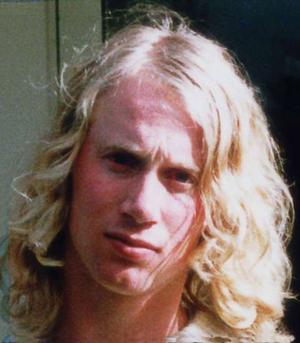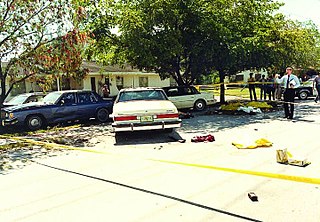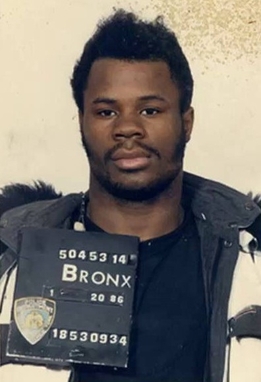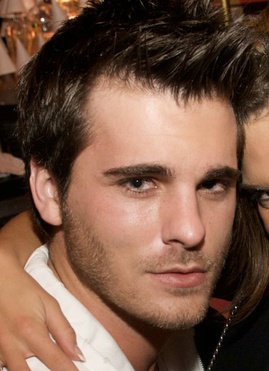Related Research Articles

Martin John Bryant is an Australian mass murderer who shot and killed 35 people and injured 23 others in the Port Arthur massacre between 28 and 29 April 1996. He is serving 35 life sentences plus 1,652 years without the possibility of parole at Risdon Prison in Hobart.

Matricide is the act of killing one's own mother.

The 1986 FBI Miami shootout occurred on April 11, 1986, in Miami-Dade County, Florida, U.S., when a small group of field agents for the FBI attempted to apprehend William Russell Matix and Michael Lee Platt, who were suspected of committing a series of violent crimes in and around the Miami metropolitan area.
This is a timeline of major crimes in Australia.

Peter Norris Dupas is an Australian convicted serial killer, currently serving three life sentences without parole for murder and primarily for being a serious habitual offender. He has a very significant criminal history involving serious sexual and violent offences, with his violent criminal history spanning more than three decades, and with every release from prison has been known to commit further crimes against women with increasing levels of violence. His criminal signature is to remove the breasts of his female victims.

Larry Davis, later known as Adam Abdul-Hakeem, was a man from New York City who gained notoriety in November 1986 for his shootout in the South Bronx with officers of the New York City Police Department, in which six officers were shot. Davis, asserting self-defense, was acquitted of all charges aside from illegal gun possession. Davis was later convicted in April 1991 of a Bronx drug dealer's 1986 murder. In 2008, Davis died via stabbing by a fellow inmate.

The French–Eversole feud was a long-running dispute between two American families which occurred primarily from 1887 to 1894 in the mountains of southeastern Kentucky, mainly in the town of Hazard in Perry County. The two instigators of the feud were Joseph C. Eversole and Benjamin Fulton French, who were both merchants and lawyers and at one time were friendly. The conflict was a media sensation and was covered by many US papers at the time. The first report was in the Louisville Courier-Journal on June 30, 1886, on Page 1. A listing of the various media reports is included at the end of this article. Ultimately, those media reports became the basis for various books written about the French–Eversole War. Based on a report by General Sam Hill to Kentucky Governor Simon Bolivar Buckner, the feud killed more than 20 men. Other historians exaggerated the numbers killed to as many as 74 deaths.
Natasha Wallen Cornett is an American criminal currently serving a sentence of life without parole at the Debra K. Johnson Rehabilitation Center in Nashville for her involvement in the Lillelid murders.

On November 29, 2009, four police officers of Lakewood, Washington were fatally shot at the Forza Coffee shop, located at 11401 Steele Street #108 South in the Parkland unincorporated area of Pierce County, Washington, near Tacoma. A gunman, later identified as Maurice Clemmons, entered the shop, shot the officers while they worked on laptops, and fled the scene with a single gunshot wound in his torso. After a massive two-day manhunt that spanned several nearby cities, an officer recognized Clemmons near a stalled car in south Seattle. When he refused orders to stop, he was shot and killed by a Seattle Police Department officer.

The history of violence against LGBT people in the United States is made up of assaults on gay men, lesbians, bisexuals, and transgender individuals (LGBT), legal responses to such violence, and hate crime statistics in the United States of America. The people who are the targets of such violence are believed to violate heteronormative rules and they are also believed to contravene perceived protocols of gender and sexual roles. People who are perceived to be LGBT may also be targeted for violence. Violence can also occur between couples who are of the same sex, with statistics showing that violence among female same-sex couples is more common than it is among couples of the opposite sex, but male same-sex violence is less common.
The Debra K. Johnson Rehabilitation Center, formerly the Tennessee Prison for Women, is a Tennessee Department of Correction prison for women located in Nashville, Tennessee.
Laurie Show was a 16-year-old sophomore at Conestoga Valley High School who was stalked by her classmates and murdered on December 20, 1991, in the United States. Her body was discovered in her Lancaster, Pennsylvania home by her mother Hazel Show with her throat having been slit. Her classmates Lisa Michelle Lambert, Tabitha Buck, and Lawrence "Butch" Yunkin were all subsequently charged with her murder.
The Port Arthur massacre was a mass shooting that occurred on 28 April 1996 at Port Arthur, a tourist town in the Australian state of Tasmania. The perpetrator, Martin Bryant, killed 35 people and wounded 23 others, the deadliest massacre in modern Australian history. The attack led to fundamental changes in Australia's gun laws.

Henry Clay Magruder was a Confederate soldier, convicted war criminal, and guerrilla during the American Civil War. Born near Lebanon, Kentucky, he took part in several major Western theater battles. Still, he is best known for his fate as a guerrilla and was possibly the inspiration of a fictional local folk hero and guerrilla fighter, Sue Munday, whose exploits closely mirrored his own.

William Devin Howell is an American serial killer who was convicted of murdering seven women in 2003. He is one of the most prolific serial killers in Connecticut history. In November 2017, while already serving a 15-year prison sentence for manslaughter, he was sentenced to six consecutive life sentences, which he is currently serving at Cheshire Correctional Institution.

On October 12, 2012, Ryan Carter Poston, an American attorney from Fort Mitchell, Kentucky, was shot to death by his on-again off-again girlfriend Shayna Michelle Hubers. After a trial in the Campbell County circuit court, Hubers was convicted of murder on April 23, 2015. She was sentenced to 40 years in the Kentucky Department of Corrections on August 14, 2015, with parole eligibility after 20 years. On August 25, 2016, Hubers' conviction was overturned on appeal when one of the jurors in her murder trial was revealed to be a convicted felon. Hubers was convicted of murder during her second trial on August 28, 2018. On October 18, 2018, she was sentenced to life imprisonment with parole eligibility after 20 years.
The Federico murder case was a criminal case which took place in Chesterfield County, Virginia, United States, in which Josh Federico shot his wife, Sarah, killed her boyfriend Lawrence Howell, and attempted to kill her unborn child. Following his arrest, Federico conspired with family members and friends to hire someone to kill his father-in-law and brother-in-law. Five people have been implicated in these crimes.
On January 28, 2019, in the Pecan Park area in the East End district of Houston, Houston Police Department (HPD) officers initiated a no-knock raid on a house, killing the two homeowners, a husband and wife: Dennis Wayne Tuttle and Rhogena Ann Nicholas. They were aged 59 and 58, respectively. Five HPD officers sustained injuries.
Larry Lamont White is an American serial killer who shot to death three women in Louisville, Kentucky from June to July 1983. Originally convicted of two murders, for which he was sentenced to death, his sentence was later overturned, and White was paroled. After being imprisoned for firearm violations in 2006, he was linked to his first murder via DNA and given a new death sentence, and he is currently awaiting execution for it.
References
- 1 2 "Routine call, horrific crime - Responding officer, others remember Lillelid family slayings". Knoxville News. April 1, 2007. Archived from the original on April 3, 2012.
- ↑ Jesse Fox Mayshark (April 20, 1998). "A Blackened Rainbow - How do we make sense of the Lillelid murders?". Metro Pulse Weekly Wire.
- ↑ Women's Entertainment Television Network (WETV) Women Behind Bars Series, Original Airdate June 16, 2009
- 1 2 3 4 5 Case of State of Tennessee v. Howell, et al., opinion filed February 29, 2000.
- 1 2 3 Helen Smith (2000). The Scarred Heart: Understanding and Identifying Kids Who Kill. Callisto. ISBN 978-0615112237.
- ↑ Six, a documentary film about the Lilleid murders and Natasha Cornett by forensic psychologist Helen Smith.
- ↑ Cornett vs State of Tennessee, Original Filed August 20, 2002
- ↑ Lillelid Sentencing, March 13, 1998.
- ↑ A.P. 7/18/1997
- ↑ Lakin, Matt. "Lillelid killer Jason Bryant wants out of prison, seeks federal hearing". Knoxville News Sentinel.
- ↑ "WGRV archive". WGRV (AM). p. 33.
- 1 2 "The Peter Lillelid: Ten Years Later". WBIR. February 13, 2007.
- ↑ "20 years later: 'Evil' killing of Powell family resonates". WBIR. April 6, 2017.
- ↑ Mjør, Kjersti (May 2, 2017). "Ein ungdomsgjeng skaut og drepte familien Lillelid i USA i 1997. Peter (2) var den einaste som overlevde" [A gang shot and killed the Lillelid family in the US in 1997. Only Peter (2) survived.]. Bergens Tidende (in Norwegian Nynorsk).
- ↑ Wilhoit, Robin (May 9, 2022). "Overcoming tragedy: Peter Lillelid 25 years later". WBIR.